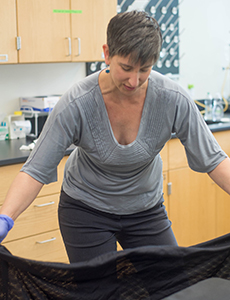The Muhlenberg Lab That Literally Buzzes with Activity
Students collected data from bumblebees to support their own projects as well as one biology professor's ongoing research.By: Meghan Kita Saturday, September 16, 2017 08:43 AM
 Katie Esbenshade ‘19 works with bees as part of her summer research in Jordanna Sprayberry's lab. Photos by Rebecca Rohn.
Katie Esbenshade ‘19 works with bees as part of her summer research in Jordanna Sprayberry's lab. Photos by Rebecca Rohn.Jordanna Sprayberry, associate professor of biology, is explaining the bumblebee research that took place in her lab over the summer. As she speaks, she pulls out a blank sheet of paper and puts it on her desk. In pencil, she writes NEUROETHOLOGY OF POLLINATION atop the page while explaining what she means.
“Pollination is this delightful phenomenon in that flowers only get to reproduce if a pollinator, like a bumblebee, comes and transfers their sex gametes to another flower,” Sprayberry says. “The ability of the animal to find the flower is really important, so one of the driving questions in my lab is: How do bumblebees use sensory information from flowers?”
She draws a bumblebee, then a flower, then an arrow pointing from bee to flower with a question mark beneath it to illustrate her point.
This continues for another 20 minutes and another six drawings, as Sprayberry takes me through two of the experiments that went on in her lab this past summer. Using different methodologies, both experiments sought to determine whether bees can perceive the difference between a familiar odor and a polluted odor. Four student researchers helped run the experiments and collect data, which will be presented at the Celebration of Student Research & Scholarship on Saturday at 11 a.m.
 Though the experiments were complex, Sprayberry (left) broke them down into language even a writer who studied magazine journalism could understand and appreciate. Her students learn this skill in addition to hands-on laboratory techniques, says Eve Balistra ‘18, a biochemistry and history major.
Though the experiments were complex, Sprayberry (left) broke them down into language even a writer who studied magazine journalism could understand and appreciate. Her students learn this skill in addition to hands-on laboratory techniques, says Eve Balistra ‘18, a biochemistry and history major.
“At Muhlenberg, a lot of the emphasis is on how to share the information you’ve gathered with people who don’t have a background in science,” Eve says. “Having to go to poster sessions and present is really good preparation for how to talk to people who may not know what you’re doing.”
The students also had time to pursue their own projects: Eve worked on designing a GPS monitor that would help researchers track bumblebee movements during field observation. Neuroscience major Katie Esbenshade ‘19 created prototypes of 3D-printed flowers with attached scent diffusers for future research on the interplay between visual and olfactory stimuli in bumblebees. Katie signed on for summer research to test whether she enjoyed being in a lab setting full-time, and she found she did—in part because of Sprayberry’s approach.
“She’s a really great mentor in that she gives you the opportunity to try and problem-solve on your own, but she’s always there if you need help,” Katie says. “I felt like I could take ownership of the work I did because I came up with most of the ideas, but she was there to help me troubleshoot when I was having issues.”
